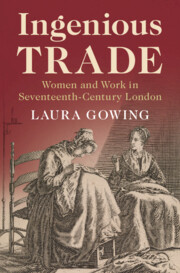Book contents
- Ingenious Trade
- Ingenious Trade
- Copyright page
- Contents
- Figures
- Tables
- Acknowledgements
- Introduction
- 1 Bred in the Exchange: Seamstresses and Shopkeepers
- 2 Girls as Apprentices
- 3 Managing the Trade: Women as Mistresses
- 4 What Girls Learned
- 5 Making Havoc: Discipline, Demeanour and Resistance
- 6 Freedoms and Customs
- Conclusion
- Appendix Who’s Who
- Bibliography
- Index
Conclusion
Published online by Cambridge University Press: 29 November 2021
- Ingenious Trade
- Ingenious Trade
- Copyright page
- Contents
- Figures
- Tables
- Acknowledgements
- Introduction
- 1 Bred in the Exchange: Seamstresses and Shopkeepers
- 2 Girls as Apprentices
- 3 Managing the Trade: Women as Mistresses
- 4 What Girls Learned
- 5 Making Havoc: Discipline, Demeanour and Resistance
- 6 Freedoms and Customs
- Conclusion
- Appendix Who’s Who
- Bibliography
- Index
Summary
In 1658, aged forty, Apolonia Browne fell ill with smallpox in London. She made her will and died a week later, to be buried at her request in the vault built by her mother’s family in St Michael, Cornhill. Amongst the legacies to her numerous nieces and nephews, ranging from beds, linen undergarments and a mare called Button, to a pepper mill and a diamond ring, she bequeathed to her sister Mary Sterry ‘the pin pillow which her Daughter wrought with the Effigies of the King & Queene thereon’. This daughter, named Apolina after her aunt and grandmother, had died sixteen years before, aged eighteen, a lodger in the City. Her pincushion, embroidered with the king and his wife, which must have been made while Charles I was still king, and cherished by her aunt, went back to her mother. Apolonia Browne had two other nieces with the same name, daughters of her brothers. To one she left a bequest of a feather bed and £50. The other became a seamstress, married John Maddox, a silk-dyer, and in 1667 took on an apprentice named Frances Angell, the young woman whose story began this book.
- Type
- Chapter
- Information
- Ingenious TradeWomen and Work in Seventeenth-Century London, pp. 243 - 250Publisher: Cambridge University PressPrint publication year: 2021

